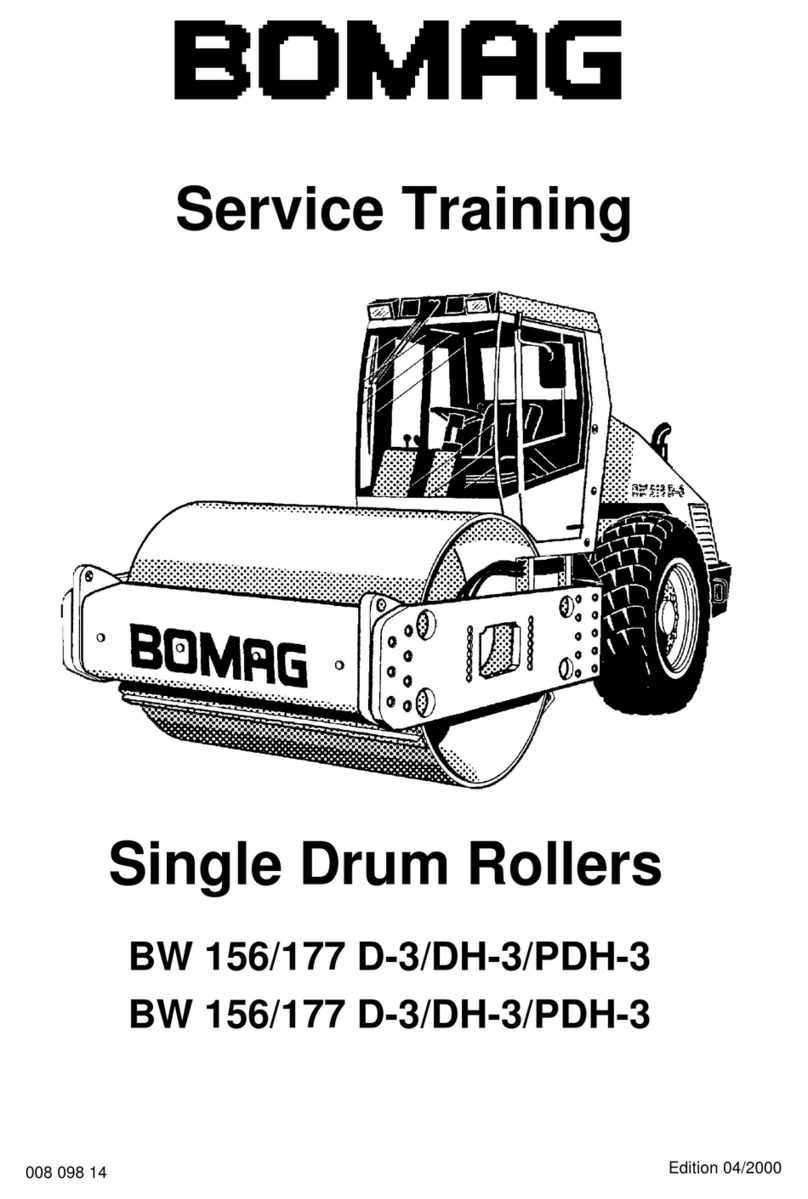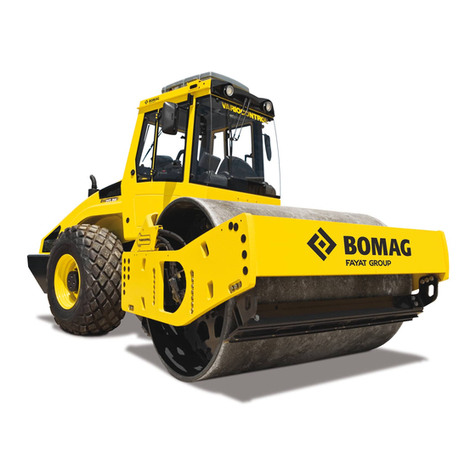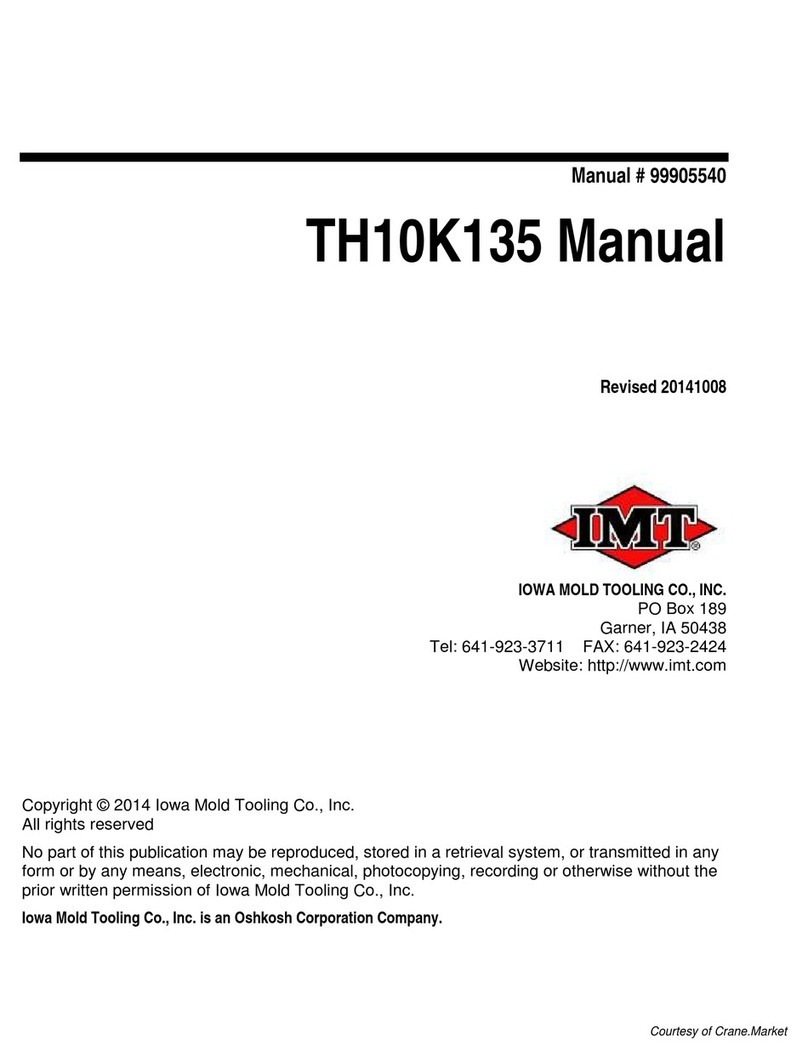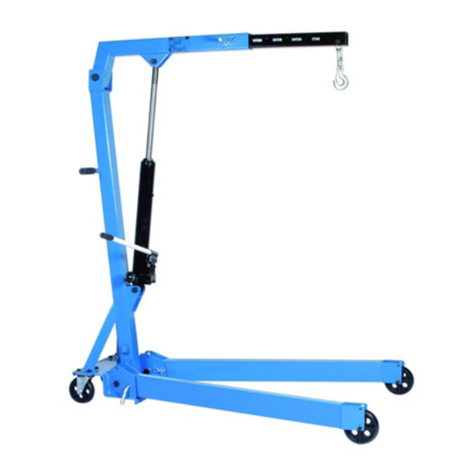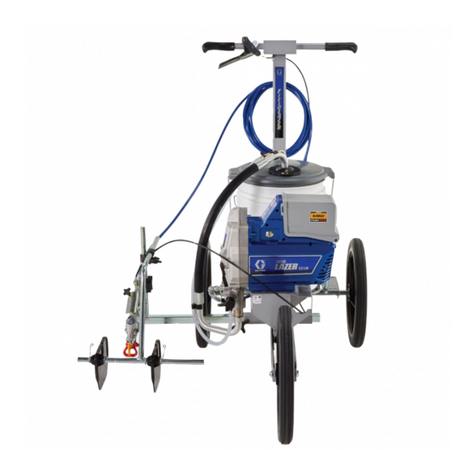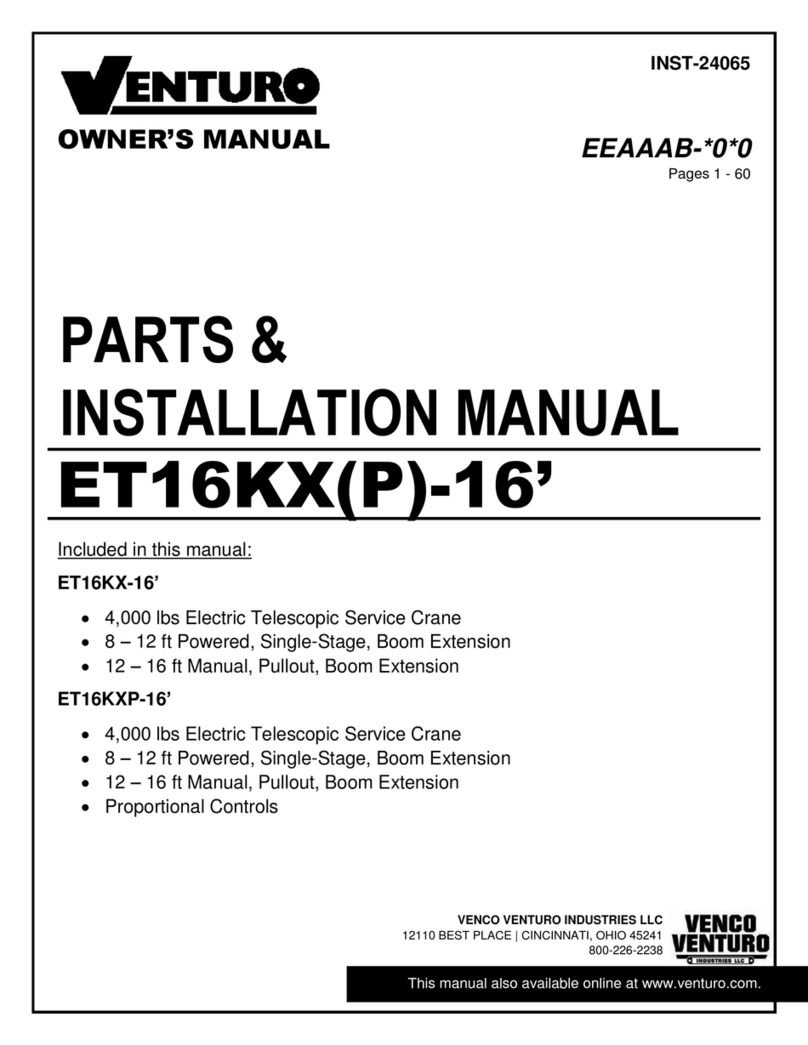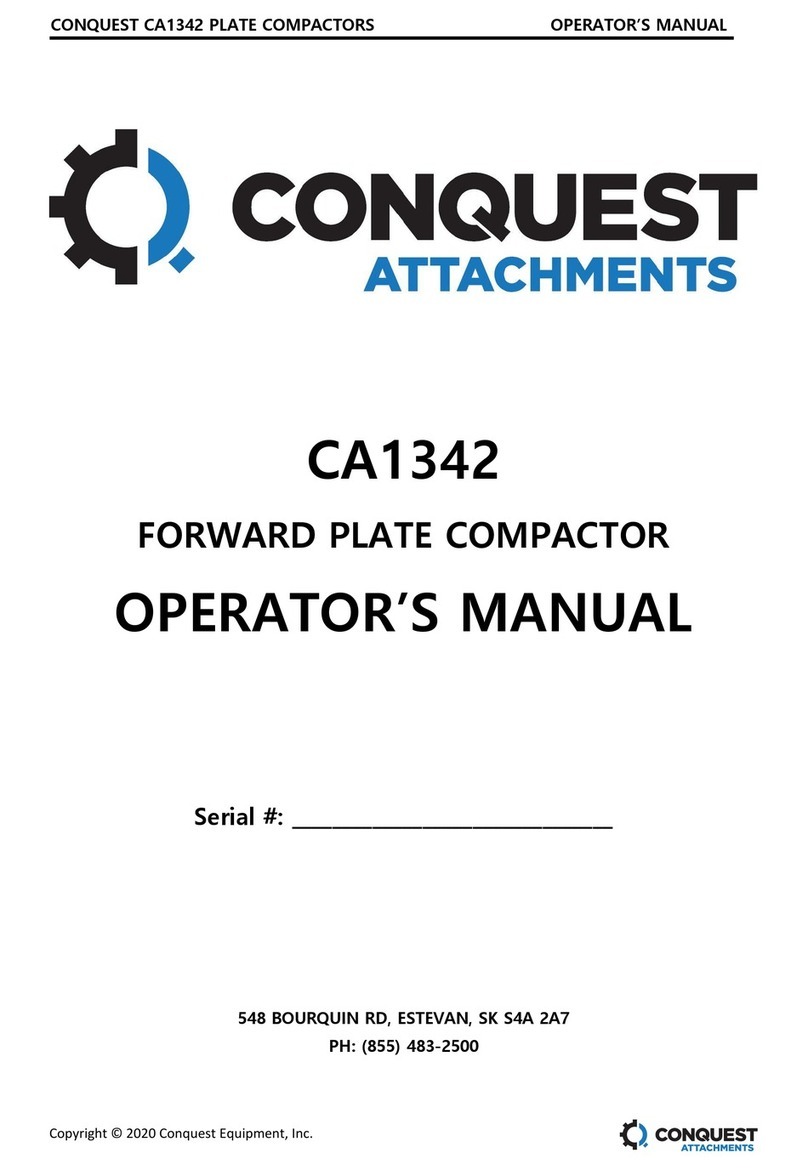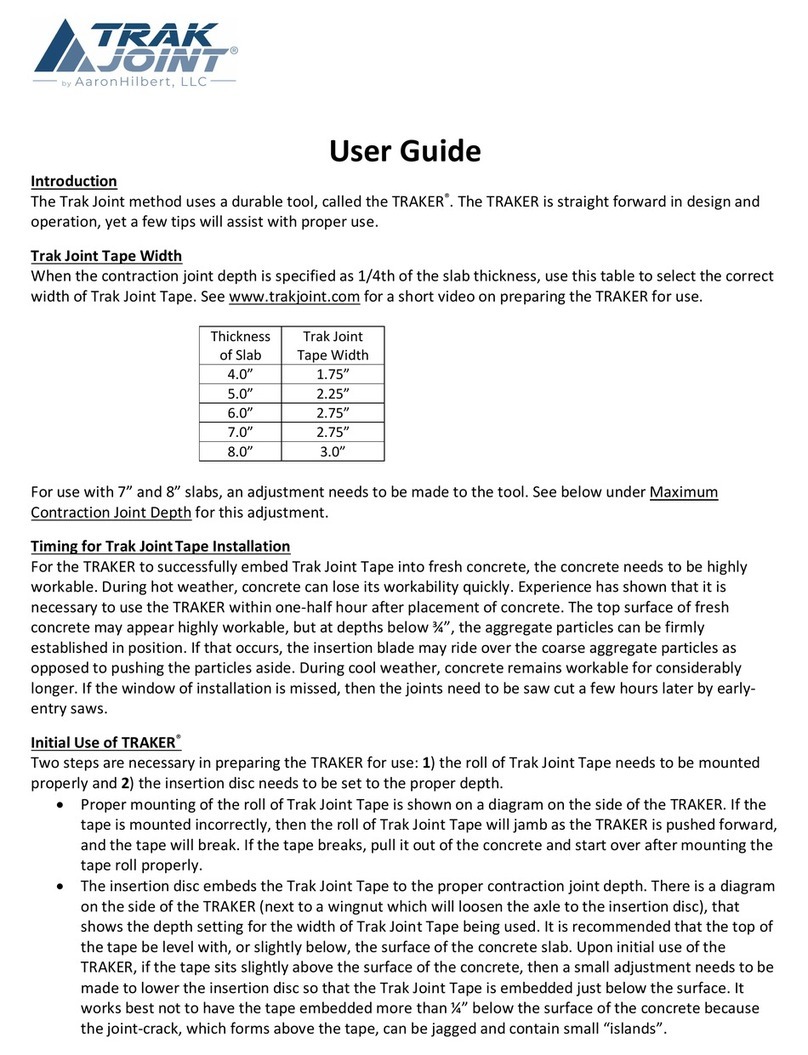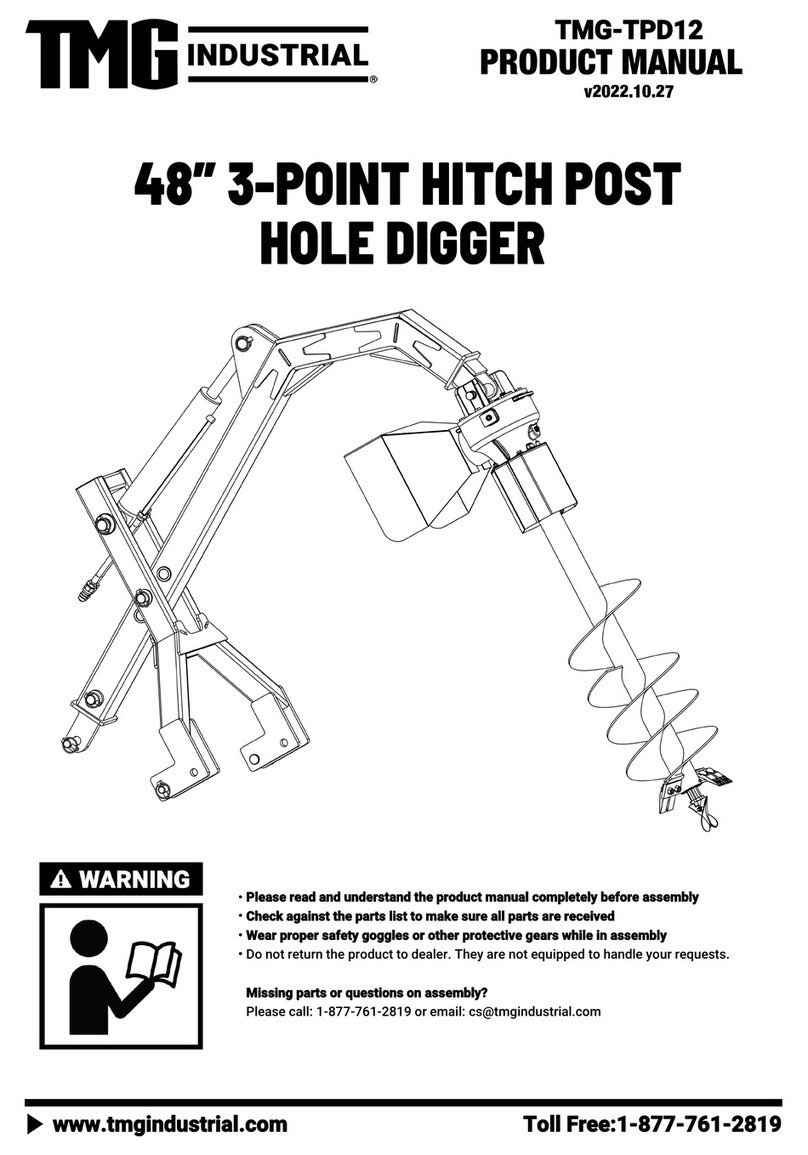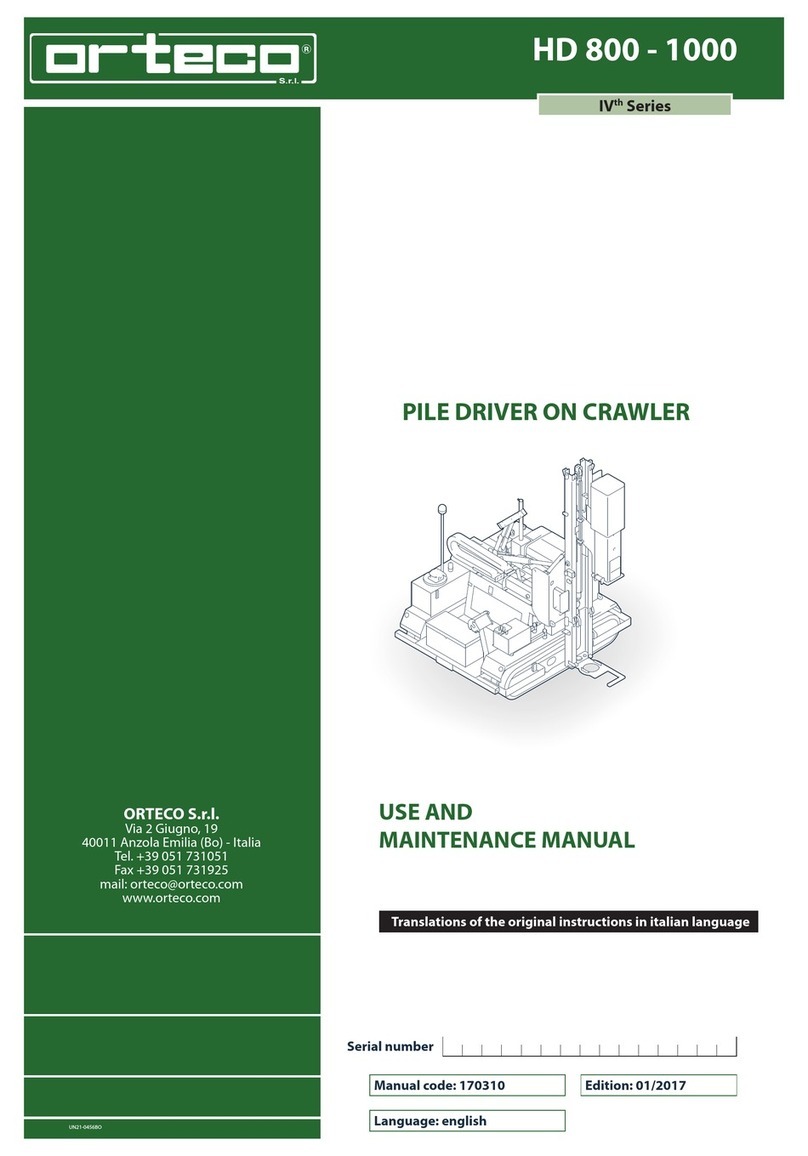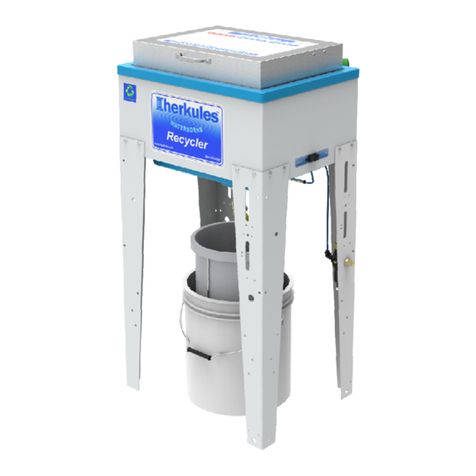Bomag BW 177 D-4 User manual

Operating instructions
Maintenance instructions
Original operating instructions
12/2012
Catalogue No.
008 053 41
BW 177 D-4
S/N 101 583 27 1241 >
Single drum roller


Foreword
BOMAG 3BW 177 D-4
1 Foreword
BOMAG manufactures machine for earth, as-
phalt and refuse compaction, stabilizers/recy-
clers as well as milling machine and finishers.
BOMAG’s vast experience in connection with
state-of-the-art production and testing meth-
ods, such as lifetime tests of all important
components and highest quality demands
guarantee maximum reliability of your ma-
chine.
This manual comprises:
lSafety regulations
lOperating instructions
lmaintenance instructions
lTrouble shooting
Using these instructions will
lhelp you to become familiar with the machine.
lavoid malfunctions caused by unprofessional
operation.
Compliance with the maintenance instructions will
lenhance the reliability of the machine on con-
struction sites,
lprolong the lifetime of the machine,
lreduce repair costs and downtimes.
BOMAG will not assume liability for the function of
the machine
lif it is handled in a way not complying with the
usual modes of use,
lif it is used for purposes other than those men-
tioned in these instructions.
No warranty claims can be lodged in case of dam-
age resulting from
loperating errors,
linsufficient maintenance and
lwrong fuels and lubricants.
Please note!
This manual was written for operators and mainte-
nance personnel on construction sites.
Always keep this manual close at hand, e.g. in the
tool compartment of the machine or in a specially
provided container. These operating and mainte-
nance instructions are part of the machine.
You should only operate the machine after you
have been instructed and in compliance with these
instructions.
Strictly observe the safety regulations.
Please observe also the guidelines of the Civil En-
gineering Liability Association ”Safety Rules for
the Operation of Road Rollers and Soil Compac-
tors” and all relevant accident prevention regula-
tions.
For your own personal safety you should only
use original spare parts from BOMAG.
For your machine BOMAG offers service kits
to make maintenance easier.
In the course of technical development we re-
serve the right for technical modifications
without prior notification.
These operating and maintenance instructions are
also available in other languages.
Apart from that, the spare parts catalogue is avail-
able from your BOMAG dealer against the serial
number of your machine.
Your BOMAG dealer will also supply you with in-
formation about the correct use of our machines in
soil and asphalt construction.
The above notes do not constitute an extension of
the warranty and liability conditions specified in the
general terms of business of BOMAG.
We wish you successful work with your BOMAG
machine.
BOMAG GmbH
Copyright by BOMAG

Foreword
BOMAG4BW 177 D-4
Please fill in
. . . . . . . . . . . . . . . . . . . . . . . . . . . .
Machine type (Fig. 1)
. . . . . . . . . . . . . . . . . . . . . . . . . . . .
Serial-number (Fig. 1 and 2)
. . . . . . . . . . . . . . . . . . . . . . . . . . . .
Engine type (Fig. 3)
. . . . . . . . . . . . . . . . . . . . . . . . . . . .
Engine number D (Fig. 4)
Note
i
Supplement the above data together with the com-
missioning protocol.
During commissioning our organisation will in-
struct you in the operation and maintenance of the
machine.
Please observe strictly the safety regulations and
all notes on risks and dangers!
Fig. 1
Fig. 2
Fig. 3
Fig. 4

Table of Contents
BOMAG 5BW 177 D-4
1Foreword 3
2 Technical Data 9
3 Safety regulations 13
4 Indicators and Controls 25
4.1 General notes 28
4.2 Description of indicators and control elements 28
4.3 Display and control elements BTM 38
4.4 Description of indicating and control elements BTM 39
4.5 Line diagram (EVIB) 41
4.6 Description of line diagram (EVIB) 43
5 Operation 45
5.1 General 46
5.2 Tests before taking into operation 46
5.3 Electronic immobilizer 47
5.4 Starting the engine 47
5.5 Starting with jump wires 49
5.6 Driving the machine 50
5.7 Stopping the machine, operating the parking brake 51
5.8 Shutting down the engine 52
5.9 Switching the vibration on and off 53
5.10 What to do in events of emergency 54
5.11 Adjusting the steering wheel 55
5.12 Adjusting the seat 56
5.13 Operating the heating/air conditioning system 56
5.14 Operating the hood 57
5.15 BVC/BTM05 settings before start-up 58
5.16 Measuring pass with BTM 61
5.17 Finishing compaction of a track 64
5.18 Printing measuring data after completing compaction 65
5.19 Changing the paper roll in the measuring value printer 66
5.20 Changing the printer ribbon in the measuring value printer 67
5.21 Towing in case of an engine failure 68
5.22 Loading/transport 70
6 Maintenance 73
6.1 General notes on maintenance 74
6.2 Fuels and lubricants 75

Table of Contents
BOMAG6BW 177 D-4
6.3 Table of fuels and lubricants 78
6.4 Running-in instructions 79
6.5 Maintenance table 80
Every 10 operating hours 83
6.6 Checking the engine oil level 83
6.7 Checking the fuel level 83
6.8 Checking the hydraulic oil level 84
6.9 Check, clean the water separator 85
Every 250 operating hours 87
6.10 Check the tire pressure 87
6.11 Cleaning the cooling fins on the radiator 87
6.12 Cleaning the cooling fins on the hydraulic oil cooler 88
6.13 Check the oil level in the drive axle 89
6.14 Check the oil level in the wheel hubs 90
6.15 Check the oil level in the vibration bearings 90
6.16 Check the parking brake 91
6.17 Checking, tensioning, replacing the refrigerant compressor V-belt 92
Every 500 operating hours 95
6.18 Changing engine oil and oil filter 95
6.19 Replace the fuel filter cartridge 96
6.20 Change the fuel pre-filter cartridge 97
6.21 Battery service 99
6.22 Draining the sludge from the fuel tank 100
6.23 Checking the V-belt tension, tightening 100
6.24 Service the air conditioning 101
6.25 Cleaning the circulation air filter for the heating 104
6.26 Changing the bypass filter 104
Every 1000 operating hours 107
6.27 Check, adjust the valve clearance 107
6.28 Check the engine mounts 108
6.29 Changing the oil in the vibration bearings 109
6.30 Change the oil in thedrive axle 110
6.31 Changing the oil in the wheel hubes 111
6.32 Retighten the fastening of the axle on the frame 112
6.33 Tightening the wheel nuts 112
6.34 Check the ROPS 113
6.35 Check the travel control 113
Every 2000 operating hours 115

Table of Contents
BOMAG 7BW 177 D-4
6.36 Changing hydraulic oil and breather filter 115
6.37 Changing the hydraulic oil filter 116
Every 3000 operating hours 119
6.38 Replace the injection valve 119
Every 5000 operating hours 121
6.39 Replacing the toothed belt 121
As required 123
6.40 Air filter maintenance 123
6.41 Adjust the scrapers 125
6.42 Clean the machine 126
6.43 Change the tires 127
6.44 Change the fresh air filter in the cabin 127
6.45 Fill the provision tank for the windscreen washer system 128
6.46 Tightening torques 128
6.47 Engine conservation 129
7 Trouble shooting 131
7.1 General notes 132
7.2 Reading out faults BVC/BTM05 132
7.3 Engine 134
8 Cab assembly before initial start-up 137
8.1 Preparations 139
8.2 Cabin assembly 140
8.3 Final function tests and checks 146
9 Disposal 147
9.1 Final shut-down of machine 148

Table of Contents
BOMAG8BW 177 D-4

BOMAG 9BW 177 D-4
2 Technical Data

Technical Data
BOMAG10 BW 177 D-4
Fig. 5
BW 177 D-4 A B D H H2 K LO1 O2 S W
Dimensions in
mm
2500 1836 1228 2225 2860 375 4913 75 75 25 1686
Weights
Max. operating weight kg 8870
Operating weight (CECE) with ROPS-cabin kg 7500
Front axle load (CECE) kg 4190
Rear axle load (CECE) kg 3310
Static linear load kg/cm 24.9
Travel characteristics
Travel speed (1) km/h 0 - 7.0
Travel speed (2) km/h 0 - 11.0
Max. gradability without/with vibration % 51/48
Drive
Engine manufacturer Deutz
Type TD 2011 L04 i
Cooling Oil
Number of cylinders 4
Rated power ISO 3046 kW 54
Rated power SAE J 1995 hp 73
Rated speed rpm 2400
Fuel Diesel
Electrical equipment V 12
Drive system hydrostatic
Permissible ambient temperatures °C -20 ... +50

Technical Data
BOMAG 11BW 177 D-4
Note
i
Subject to technical alterations.
Brakes
Service brake hydrostatic
Parking brake hydro-mechanical
Steering
Type of steering Oscill.-articul.
Steering operation hydrostatic
Inner track radius mm 3132
Steering angle +/-° 35
Oscillation angle +/-° 12
Vibration
Drive system hydrostatic
Frequency (1/2) Hz 30/40
Amplitude (1/2) mm 1.9/0.95
Centrifugal force (1/2) kN 135/120
Tires
Tire size 14.9-24/6PR
Air pressure bar 1.9
Filling capacities
Fuel (diesel) l approx. 150

Technical Data
BOMAG12 BW 177 D-4
The following noise and vibration data acc. to
- EC Machine Regulation edition 2006/42/EC
- the noise regulation 2000/14/EG, noise protection guideline 2003/10/EC
- Vibration Protection Regulation 2002/44/EC
were determined during conditions typical for this type of equipment and by application of harmo-
nized standards.
During operation these values may vary because of the existing operating conditions.
Noise value
sound pressure level at the work place of the operator (with cabin):
LpA = 79 dB(A), determined acc. to ISO 11204 and EN 500
Guaranteed sound power level:
LWA = 103 dB(A), determined acc. to ISO 3744 and EN 500
Vibration value
Vibration of the entire body (driver’s seat)
The weighted effective acceleration value determined according to ISO 7096 is ≤0.5 m/s2.
Hand-arm vibration values
The weighted effective acceleration value determined according to ISO 5349 is ≤2.5 m/s2.

BOMAG 13BW 177 D-4
3 Safety regulations

Safety regulations
BOMAG14 BW 177 D-4
General
This BOMAG machine has been built in com-
pliance with the latest technical standard and
complies with the applicable regulations and
technical rules. However, dangers for persons
and property may arise from this machine, if:
lit is used for purposes other than the ones it is
intended for,
lit is operated by untrained personnel,
lit is changed or converted in an unprofessional
way,
lthe safety instructions are not observed.
Each person involved in the operation, mainte-
nance and repair of the machine must there-
fore read and comply with these safety
regulations. If necessary, this must be con-
firmed by obtaining the signature of the cus-
tomer.
Furthermore, the following obviously also applies:
lapplicable accident prevention instructions,
lgenerally accepted safety and road traffic reg-
ulations,
lcountry specific safety regulations. It is the
duty of the operator to be acquainted with
these instructions and to apply these accord-
ingly. This applies also for local regulations
concerning different types of handling work.
Should the recommendations in these instruc-
tions be different from the regulations valid in
your country, you must comply with the safety
regulations valid in your country.
Intended use
This machine must only be used for:
lmedium to heavy compaction work in earth
construction (road sub-bases)
lprobably compaction of bituminous material,
e.g. road surface layers.
Unintended use
Dangers may arise from the machine when it is
used for purposes other than the one it is intended
for.
Any danger caused by intended use is the sole re-
sponsibility of the customer or driver/operator, the
manufacturer cannot be made liable.
Examples for unintended use are:
lwork with vibration on hard concrete, cured bi-
tumen layers or extremely frozen ground
ldriving on unstable subbases or too small con-
tact area (danger of tipping over)
lusing the machine for towing
luse to pull down walls or demolish buildings
Transporting persons, except the machine driver,
is prohibited.
Starting and operation of the machine in explosive
environments and in underground mining is pro-
hibited.
Remaining dangers, remaining risks
Despite careful work and compliance with stand-
ards and regulations it cannot be ruled out that fur-
ther dangers may arise when working with and
handling the machine.
Both the machine as well as all other system com-
ponents comply with the currently valid safety reg-
ulations. Nevertheless, remaining risks cannot be
ruled out completely, even when using the ma-
chine for the purpose it is intended for and follow-
ing all information given in the operating
instructions.
A remaining risk can also not be excluded beyond
the actual danger zone of the machine. Persons
remaining in this area must pay particular attention
to the machine, so that they can react immediately
in case of a possible malfunction, an incident or
failure etc.
All persons remaining ion the area of the machine
must be informed about the dangers that arise
from the operation of the machine.
Regular safety inspections
Have the machine inspected by an expert (capa-
ble person) as required for the conditiosn the ma-
chine is working under, but at least once every
year.
Who is allowed to operate the ma-
chine?
Only trained, instructed and authorized persons of
at least 18 years of age are permitted to drive and
operate this machine. For operation of the ma-
chine the responsibilities must be clearly specified
and complied with.

Safety regulations
BOMAG 15BW 177 D-4
Persons under the influence of alcohol, medicine
or drugs are not allowed to operate, service or re-
pair the machine.
Maintenance and repair work requires specific
knowledge and must therefore only be performed
by trained specialists.
Changes and conversions to the ma-
chine
Unauthorized changes to the machine are prohib-
ited for safety reasons.
Original parts and accessories have been special-
ly designed for this machine.
We wish to make explicitly clear that we have not
tested or approved any parts or accessories not
supplied by us.
The installation and/or use of such products may
have an adverse effect on the active and/or pas-
sive safety.
The manufacturer explicitly excludes any liability
for damage caused by the use of non-original
parts or accessories.
Damage, deficiencies, misuse of safety
installations
Machines which are not safe to operate or in traffic
must be immediately taken out of service and shall
not be used, until these deficiencies have been
properly rectified.
Safety installations and switches must neither be
removed nor must they be made ineffective.
Notes on safety in the operating and
maintenance instructions:
Danger!
Paragraphs marked like this highlight possible
dangers for persons.
Caution
!
Paragraphs marked like this highlight possible
dangers for machines or parts of the machine.
Note
i
Paragraphs marked like this contain technical in-
formation for the optimal economical use of the
machine.
Environment
Paragraphs marked like this point out practic-
es for safe and environmental disposal of fuels
and lubricants as well as replacement parts.
Observe the regulations for the protection of
the environment.
Loading the machine
Use only strong and stable loading ramps. The
ramp inclination must be lower than the gradability
of the machine.
Secure the machine against turning over or slip-
ping off.
Secure the machine on the transport vehicle
against rolling off, slipping and turning over.
Persons are highly endangered if
lthey step or stand under loads being lifted
lthey remain in the drive range of the machine
during a demonstration or during loading.
The machine must not swing about when lifted off
the ground.
Use only safe lifting gear of sufficient load bearing
capacity.
Attach the lifting gear only to the specified lifting
points.
Towing the machine
Since the machine is not fitted with a towing hitch,
the machine cannot be towed with a tow bar.
If the machine has to be towed urgently out of the
danger zone because of other risks, this must only
be done on level ground or uphill using chains and
ropes. For this purpose towing ropes of sufficient
tensile strength must be fastened on the lifting
eyes.
After releasing the brake the machine can only be
braked by the towing vehicle.
Before releasing the brake block the machine with
chocks to prevent unintended rolling.

Safety regulations
BOMAG16 BW 177 D-4
Checking the Roll Over Protective
Structure (ROPS)
Note
i
On machines with cab the ROPS is an integral part
of the cab.
The frame of the machine must not be warped,
bent or cracked in the area of the ROPS fastening.
The ROPS must not show any rust, damage, hair-
line cracks or open fractures.
The actual weight of the machine must not exceed
the testing weight of the ROPS.
The ROPS must not rattle about when driving.
This indicates that it is not properly fastened. All
bolted connections must comply with the specifi-
cations and should be absolutely tight (observe
the tightening torques). Screw and nuts must not
be damaged, bent or deformed.
With the cab assembled check also the state of the
cabin mounts (rubber elements and screws).
No accessories may be welded or bolted on and
no additional holes must be drilled without the con-
sent of the manufacturer, since this will impair the
strength of the unit.
The ROPS must therefore also not be straight-
ened or repaired if it is damaged.
A defect ROPS must generally be replaced with an
original spare part in close coordination with the
manufacturer.
Starting the machine
Before starting
Operation of the machine is only permitted when
sitting in the operator's seat.
Use only machines which have been properly
serviced at regular intervals.
Become acquainted with the equipment, the con-
trol elements, the working mode of the machine
and the area you will be working in.
Use your personal protective outfit (hard hat, safe-
ty boots etc.).
Check before mounting the machine if:
lthere are persons or obstructions beside or
under the machine
lthe machine is free of any oily and combustible
material
lall handrails, steps and platforms are free of
grease, oils, fuels, dirt, snow and ice
lthe engine compartment hood is closed and
locked
To climb onto the machine use steps and hand-
rails.
Check before starting, whether:
lthe machine shows any obvious defects
lall protective devices are properly secured in
their place
lsteering, brakes, control elements, lighting
and warning horn are in order
lthe seat is correctly adjusted
lthe mirrors (if available) are clean and correct-
ly adjusted.
Do not start the machine if any gauges, control
lights or controls are defective.
Do not take any loose objects with you or fasten
them to the machine.
On machines with ROPS you should always wear
your seat belt!
Starting
Start and operate the machine only from the oper-
ator's seat
For starting set all control levers to "neutral posi-
tion".
Do not use any starting aids such as Start Pilot or
ether.
After starting check all gauges.
Starting with jump leads
Connect plus with plus and minus with minus
(ground cable) - always connect the ground cable
last and disconnect it first! Wrong connections
may cause severe damage in the electric system.
Never start the engine by bridging the electrical
connections on the starter, because the machine
would probably start to move immediately.
Starting in closed rooms
Exhaust gases are toxic! Always ensure an ade-
quate supply of fresh air when starting in closed
rooms!

Safety regulations
BOMAG 17BW 177 D-4
Driving the machine
Persons in the danger area
If a machine has turned over and the cabin door is
jammed, the right hand cabin window can be used
as an escape door.
Before taking up work, also after breaks, you
should always convince yourself that the danger
zone is free of persons or obstructions, especially
when driving in reverse.
Give warning signals, if necessary. Stop work im-
mediately if persons remain in the danger zone,
despite the warning.
Do not step or stand in the articulation area of the
machine when the engine is running. Danger of
squashing!
Driving
Always wear the seat belt when driving.
Do not drive on bases with insufficient load bear-
ing capacity.
Do not drive on ice and snow.
In events of emergency and in case of danger ac-
tuate the emergency stop switch immediately. Do
not use the emergency stop switch as service
brake.
Restart the machine only after the danger that
caused the actuation of the emergency stop switch
has been eliminated.
If the machine has contacted high-voltage power
lines:
ldo not leave the operator’s stand,
lwarn others from coming close to or touching
the machine,
lif possible drive the machine out of the danger
zone,
lhave the power switched off.
Operate the machine only from the operator’s
stand.
Keep the cabin doors closed.
Do not adjust the driver’s seat while driving.
Do not climb onto or off the machine while the ma-
chine is driving.
Change the travel direction only at standstill.
Do not use the machine to transport persons.
In case of unusual noises and development of
smoke perform trouble shooting and have the fault
corrected.
Always keep a sufficient distance to excavation
walls and embankments and do not use working
methods that could impair the stability of the ma-
chine.
Do not work with vibration on hard concrete, cured
bitumen layers or extremely frozen ground.
Always keep a sufficient distance when passing
through subways, under bridges, tunnels, electric
power lines etc.
Driving on inclinations and slopes
Do not drive on gradients exceeding the maximum
gradability of the machine.
On slopes drive extremely careful and always di-
rectly up or down the slope. Change to a lower
gear before starting to drive.
Wet and loose soils considerably reduce the
ground adhesion of the machine on inclinations
and slopes. Higher risk of accident!
Inclination
Fig. 6
The tipping angle was measured in static condition
on level, hard ground with the machine stopped,
no steering and without vibration.
With loose soil, acceleration/deceleration, running
vibration, steering or attached accessoriies the tip-
ping angle may be considerably lower.
Driving across slopes should therefore be strictly
avoided, because of the high risk of tipping over
and the related risk of severe or even fatal acci-
dents.

Safety regulations
BOMAG18 BW 177 D-4
You should therefore always drive straight up or
down a slope.
Behaviour in traffic
Match the speed to the working conditions. Do not
make extreme steering movements when driving
with high speed, danger of tipping over!
Always give way to loaded transport vehicles.
Switch the lights on if the visibility is poor.
Keep away from edges and embankments.
Checking the effect of vibration
When compacting with vibration you must check
the effect on nearby buildings and underground
supply lines (gas, water, sewage, electric power),
if necessary stop compaction work with vibration.
Do not activate the vibration on hard (frozen, con-
crete) ground. Danger of bearing damage!
Parking the machine
Park the machine on horizontal, level, firm ground.
Before leaving the machine:
lStraighten the articulated joint to provide easi-
er access to the machine.
lreturn the control lever to neutral position
lapply the parking brake
lshut the engine down, pull the ignition key off
lclose the cabin
lsecure the machine against unintended use.
Do not jump off the machine, but use hand grips
and access steps.
Mark machines, which could be in the way, with a
clearly visible sign.
Parking on slopes and inclinations
Secure the machine against rolling, place metal
chocks in front of and behind the wheels. The
wheel chocks must be provided by the operating
company.
Refuelling
Do not inhale any fuel fumes.
Refuel only with the engine shut down.
Do not refuel in closed rooms.
No open fire, do not smoke.
Monitor the entire refuelling process.
Do not spill any fuel. Catch running out fuel, do not
let it seep into the ground.
Wipe off spilled fuel. Keep dirt and water away
from the fuel.
A leaking fuel tank can cause an explosion. En-
sure tight fit of the fuel tank cover, if necessary re-
place immediately.
Fire protection measures
Familiarise yourself with the location and the oper-
ation of fire fighting equipment. Observe all fire re-
porting and fire fighting possibilities.
Maintenance work
Comply with the maintenance work described in
these operating and maintenance instructions, in-
cluding the information concerning the replace-
ment of parts.
Maintenance work must only be performed by
qualified and authorized persons.
Support the engine hood for all maintenance and
repair work in the engine compartment.
Do not touch hot engine parts.
For overhead maintenance and assembly work
use the access steps and working platforms pro-
vided or other secure means. Do not use machine
parts as access steps.
Keep unauthorized persons away from the ma-
chine.
Do not perform maintenance work while the ma-
chine is driving or the engine is running.
Park the machine on horizontal, level, firm ground.
Remove the key from the ignition switch.
Secure the articulated joint with the articulation
lock.
Work on hydraulic lines
Relieve hydraulic pressures before working on hy-
draulic lines. Hydraulic oil escaping under pres-
sure can penetrate the skin and cause severe
injury. When being injured by hydraulic oil consult
a medical doctor immediately, as otherwise this
may cause severe infections.
Do not step in front of or behind the drums/wheels
when performing adjustment work in the hydraulic
system.

Safety regulations
BOMAG 19BW 177 D-4
Do not change the setting of pressure relief valves.
Drain the hydraulic oil at operating temperature –
danger of scalding!
Any hydraulic oil must be caught and disposed of
in an environmentally friendly manner.
Always catch and dispose of hydraulic oils sepa-
rately.
Do not start the engine after draining the hydraulic
oil.
Once all work is completed (with the system still
depressurized!) check all connections and fittings
for leaks.
Changing hydraulic hoses
Hydraulic hoses must not be mixed up by mistake.
Hydraulic hoses must be visually inspected at reg-
ular intervals.
Hydraulic hoses must be immediately replaced if:
lthe outer layer is damaged down to the inlay
(e.g. chafing, cuts, cracks),
lembrittlement of the outer layer (formation of
cracks in the hose material)
lthe hose shows deformations in pressurized
and depressurized condition, which do not
comply with the genuine shape of the hydrau-
lic hose,
lthe hose shows deformations in bends, e.g.
squeezing, buckling, layer separation, forma-
tion of blisters,
lparts of the hose are leaking,
lhoses are not correctly installed,
lthe hydraulic hose has separated from the fit-
ting,
lthe fitting shows corrosion that impairs both
function and strength,
lfittings are damaged or deformed, whereby
the function and strength of the hose - hose
connection is impaired.
lthe permissible storage and usage period is
exceeded.
Only genuine BOMAG replacement hydraulic hos-
es ensure that the correct hose type (pressure
range) is used at the right location.
Working on the engine
Do not work on the fuel system while the engine is
running - danger to life due to high pressures!
lWait another minute after the engine has
stopped.
lKeep out of the danger zone during the initial
test rung.
lIn case of leaks return to the workshop imme-
diately.
lMake sure that the engine cannot be started
unintentionally during service and repair work.
Drain the engine oil at operating temperature –
danger of scalding!
Wipe off spilled oil, catch running out oil and dis-
pose of environmentally.
Store used filters and other oil contaminated ma-
terials in a separate, specially marked container
and dispose of environmentally.
Do not leave any tools or other objects, that could
cause damage, in the engine compartment.
The settings for idle speed and highest speed
must not be changed, since this would affect the
exhaust gas values and cause damage to engine
and power train.
Turbo chargers work with high speeds and high
temperatures. Keep hands, tools and materials
away from the intake and outlet openings of the
turbo charger and do not touch any hot surfaces.
Check and change coolant only when the engine
is cold.
Catch coolant and dispose of environmentally.
Working on electric parts of the machine
Before starting to work on electric parts of the ma-
chine disconnect the battery and cover it with insu-
lating material.
Do not use fuses with higher ampere ratings and
do not bridge fuses - fire hazard!
Disconnect battery and plugs from the control
units before starting welding work on the machine.
Working on the battery
When working on the battery do not smoke, do not
use open fire!
Do not let acid come in contact with hands or
clothes! When injured by acid flush off with clear
water and seek medical advice.

Safety regulations
BOMAG20 BW 177 D-4
Metal objects (e.g. tools, rings, watch straps) must
not come in contact with the battery poles – dan-
ger of short circuit and burning!
When recharging non-serviceable batteries re-
move all plugs, to avoid the accumulation of explo-
sive gases.
Observe the applicable instructions when starting
with an auxiliary battery.
Dispose of old batteries according to regulations.
Switch off the charging current before removing
the charging clamps.
Ensure sufficient ventilation, especially if the bat-
tery is to be charged in a closed room.
Working on the fuel system
Do not inhale any fuel fumes.
Avoid open fire, do not smoke, do not spill any fuel.
Catch running out fuel, do not let it seep into the
ground and dispose off environmentally.
Working on wheels and tires
Explosion-like bursting of tires or parts of tires and
rims can cause most severe or even deadly inju-
ries.
Install the tires only if are sufficiently experienced
and with the right tools at hand. If necessary have
the tires assembled in a qualified workshop.
Always ensure the correct tire pressure and do not
exceed the specified maximum pressure.
Check tires and wheels every day for specified
pressure, cuts, bulges, damaged rims, missing
wheel studs or nuts. Do not drive with damaged
tires or wheels.
Ant-sticking emulsions for tires must only consist
of water and anti-sticking agent, in a concentration
in accordance with the specifications of the manu-
facturer of the anti-sticking agent. Observe appli-
cable environmental regulations.
Working on the air conditioning
Faults on the air conditioning should only be rem-
edied by professional personnel.
According to the regulation for pressure reservoirs
all pressure reservoirs must be repeatedly inspect-
ed by a specialist.
In connection with this inspection the drier/collec-
tor unit must be visually examined twice every
year. During these inspections special attention
must be paid to corrosion and mechanical dam-
age.
Do not perform welding work in the vicinity of the
air conditioning. Danger of explosion!
Do not clean the condenser in the air conditioning
system with a hot water jet. Danger of explosion!
Do not release refrigerant into the atmosphere, but
dispose of environmentally.
Cleaning work
Do not perform cleaning work while the motor is
running.
Do not use gasoline or other easily inflammable
substances for cleaning.
When cleaning with steam cleaning equipment do
not subject electrical parts and insulation material
to the direct jet of water, or cover it beforehand.
lDo not guide the water jet into the exhaust and
into the air filter.
After maintenance work
After all maintenance work is completed reinstall
all guards and safety installations.
Repair
Mark a defective machine by attaching a warning
tag to the steering wheel.
Repair work must only be performed by qualified
and authorized persons. Use our repair instruc-
tions for this work.
Exhaust gases are highly dangerous! Always en-
sure an adequate supply of fresh air when starting
in closed rooms!
Do not work on the fuel system while the engine is
running - danger to life!
The system is under high pressure! Keep away
from leakages in the high pressure system, be-
cause fuel squirting out may cause severe injury.
After shutting down the engine wait for another
minute, until the pressure has dropped to a per-
missible level. In case of leakages you should con-
tact the Service Department of the engine
manufacturer and refrain from starting the engine.
Test
The safety of compaction equipment must be
checked by a specialist as required in dependence
on the application and the operating conditions,
however at least once every year.
Table of contents
Other Bomag Construction Equipment manuals
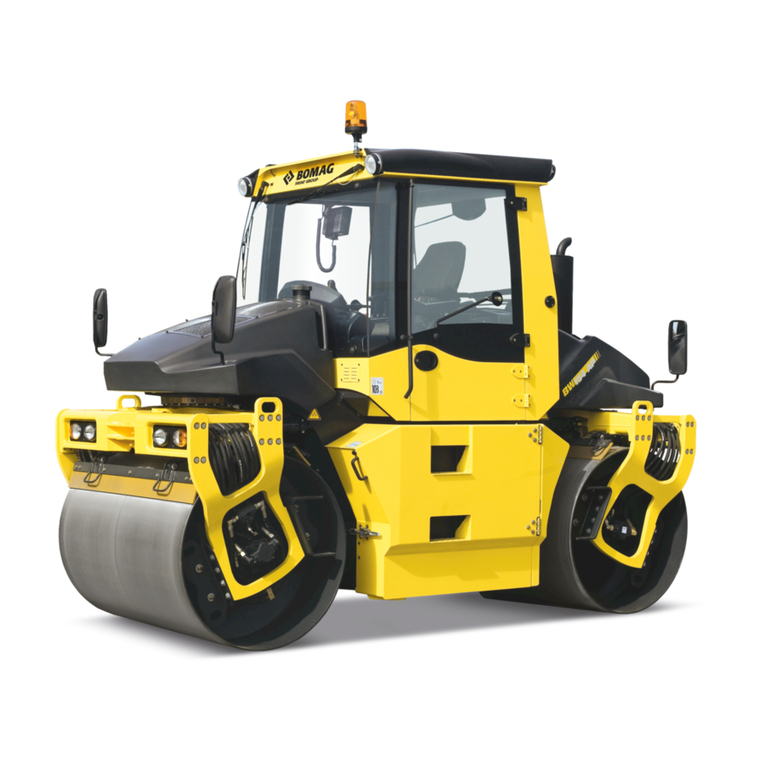
Bomag
Bomag BW 154 AP-4 User manual
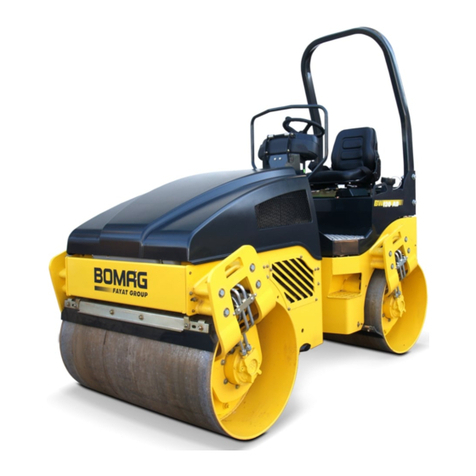
Bomag
Bomag BW 100 AD-4 User manual
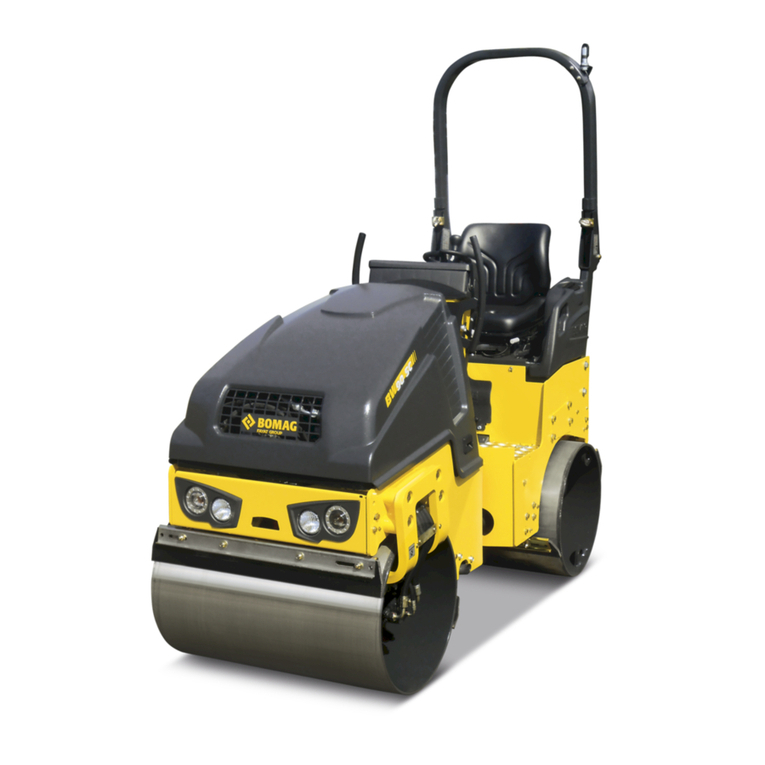
Bomag
Bomag BW 80 AD-5 User manual

Bomag
Bomag BW 900-2 User manual
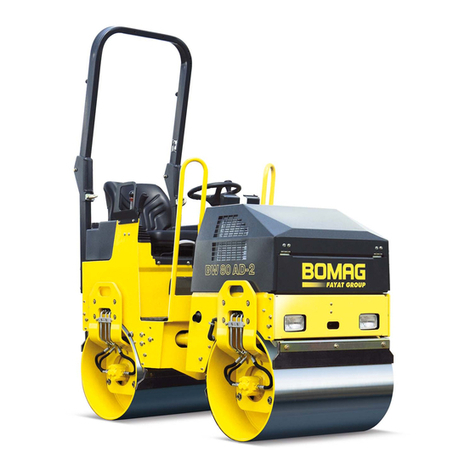
Bomag
Bomag BW 80 AD-2 Instructions for use
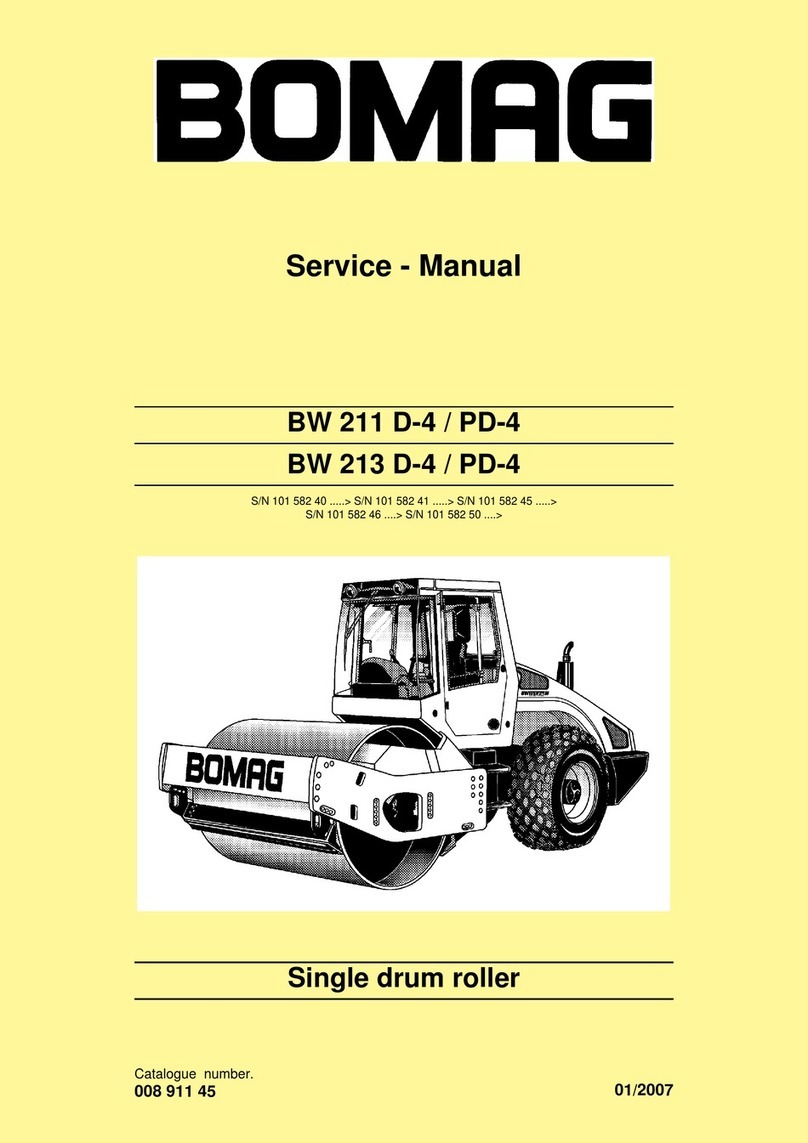
Bomag
Bomag BW 211 D-4 User manual
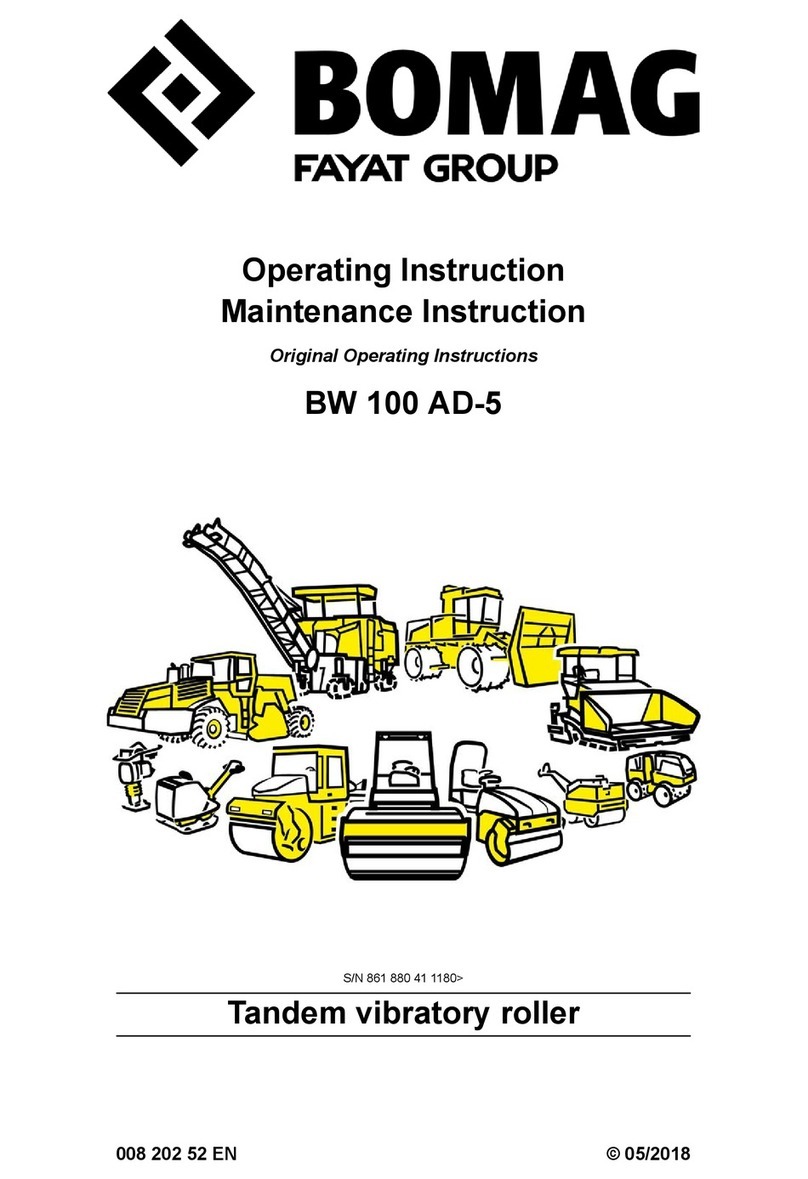
Bomag
Bomag BW 100 AD-5 Installation and operation manual
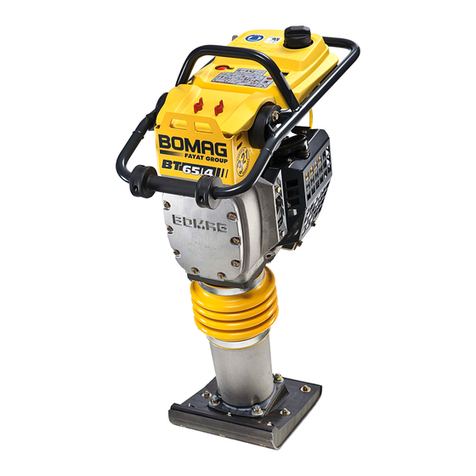
Bomag
Bomag BT 60/4 User manual

Bomag
Bomag BVP 10/36 User manual
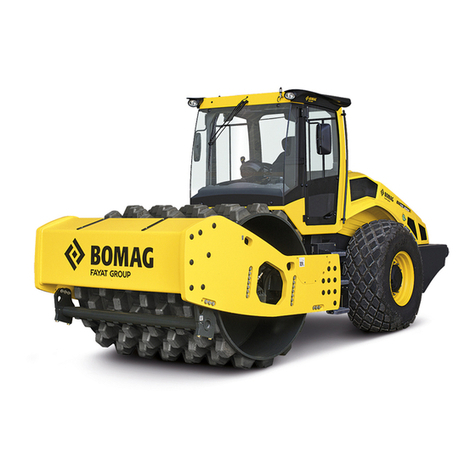
Bomag
Bomag BW 219 DH-4 Manual
Popular Construction Equipment manuals by other brands
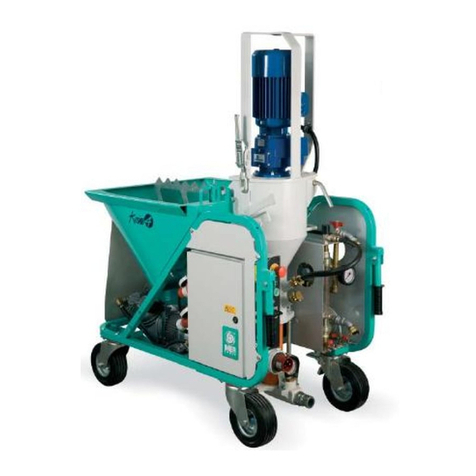
IMER
IMER KOINE 4 1106005 Operating, maintenance, spare parts manual
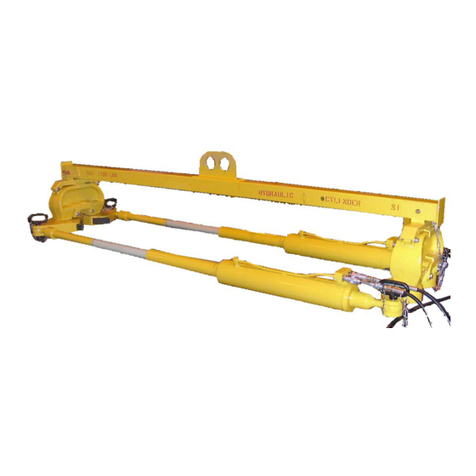
GEISMAR
GEISMAR TH 70 STP Instructions for use and maintenance
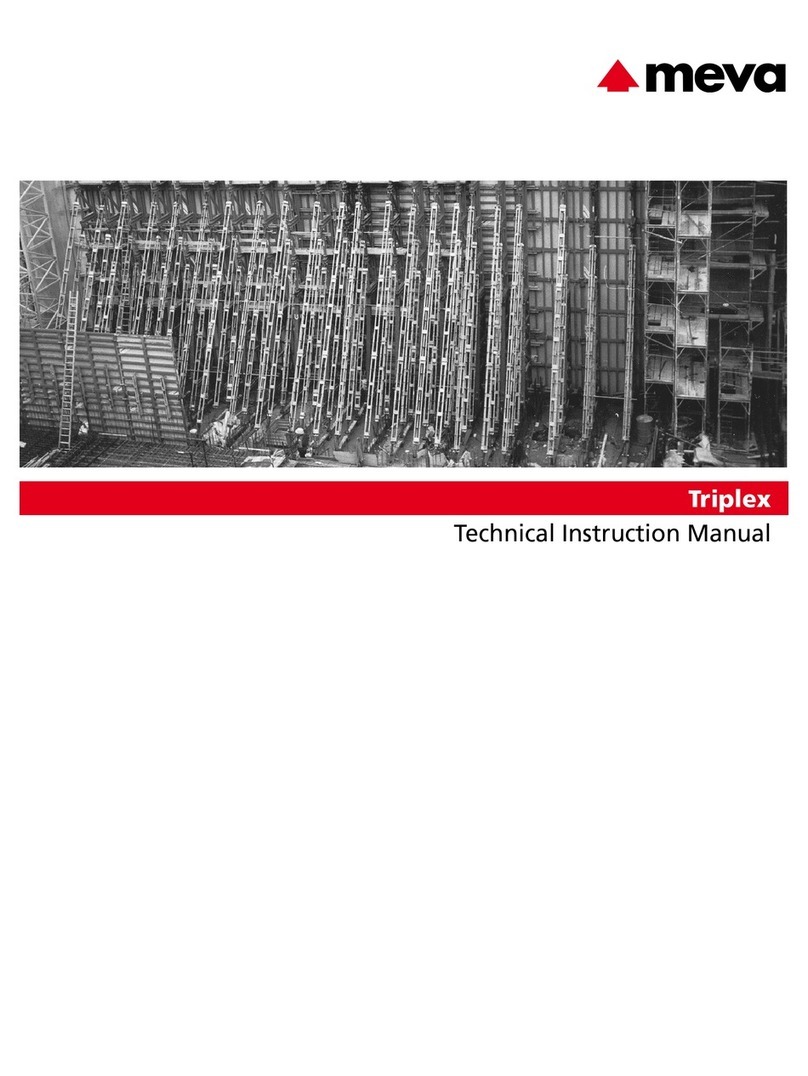
Meva
Meva Triplex Technical instruction manual
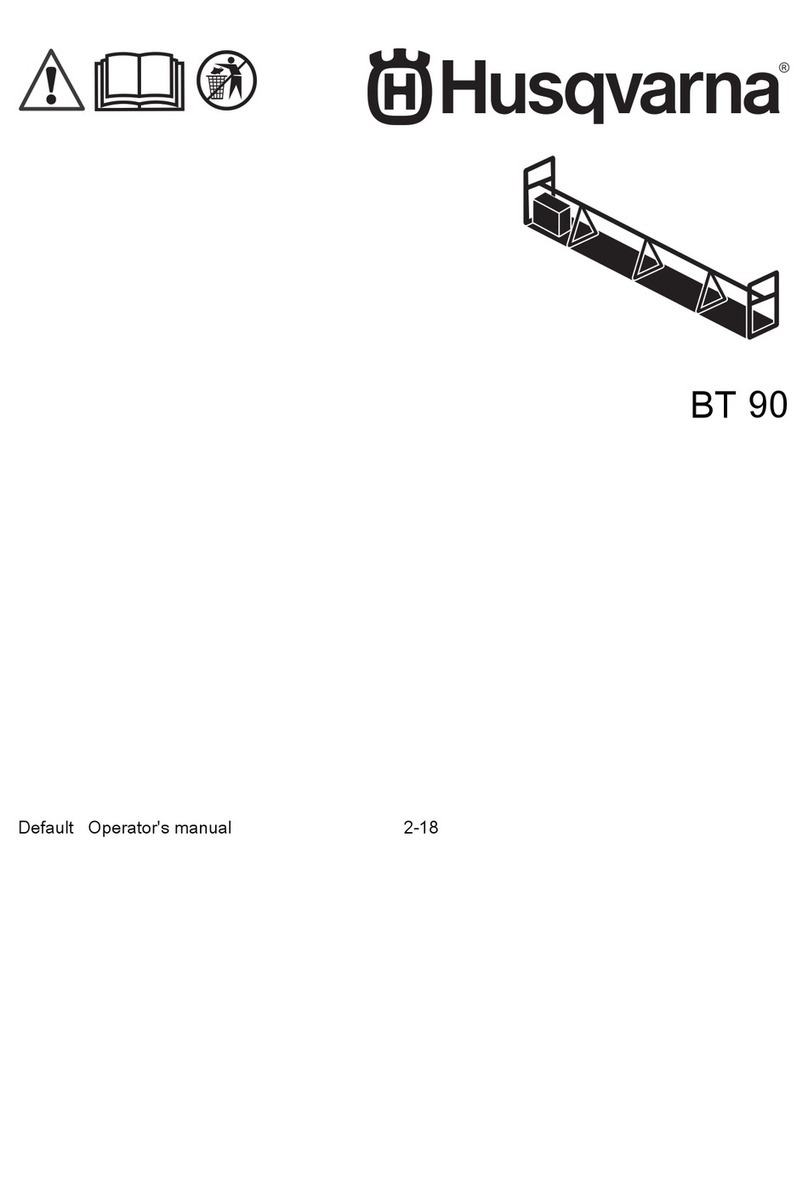
Husqvarna
Husqvarna BT 90 Series Operator's manual

Pro-tools
Pro-tools HB-302 Instruction Set

Lakeside
Lakeside ALTO Ultima Assembly guide
